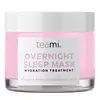What's inside
What's inside
 Key Ingredients
Key Ingredients

 Benefits
Benefits

 Concerns
Concerns

 Ingredients Side-by-side
Ingredients Side-by-side

Water
Skin ConditioningGlycerin
HumectantDimethicone
EmollientHydroxyethyl Acrylate/Sodium Acryloyldimethyl Taurate Copolymer
Emulsion StabilisingDurvillaea Potatorum Extract
HumectantUndaria Pinnatifida Extract
Skin ConditioningSesamum Indicum Seed Oil
EmollientHydrolyzed Collagen
EmollientSodium Hyaluronate
HumectantOlea Europaea Fruit Oil
MaskingHelianthus Annuus Seed Oil
EmollientButyrospermum Parkii Butter
Skin ConditioningDaucus Carota Sativa Seed Oil
EmollientParfum
MaskingCitrus Limon Peel Oil
MaskingMentha Piperita Oil
MaskingMentha Spicata Herb Oil
PerfumingJuniperus Mexicana Wood Oil
PerfumingDimethiconol
EmollientTocopheryl Acetate
AntioxidantXanthan Gum
EmulsifyingDisodium EDTA
BHT
AntioxidantTriethanolamine
BufferingCaprylyl Glycol
EmollientPhenoxyethanol
PreservativeWater, Glycerin, Dimethicone, Hydroxyethyl Acrylate/Sodium Acryloyldimethyl Taurate Copolymer, Durvillaea Potatorum Extract, Undaria Pinnatifida Extract, Sesamum Indicum Seed Oil, Hydrolyzed Collagen, Sodium Hyaluronate, Olea Europaea Fruit Oil, Helianthus Annuus Seed Oil, Butyrospermum Parkii Butter, Daucus Carota Sativa Seed Oil, Parfum, Citrus Limon Peel Oil, Mentha Piperita Oil, Mentha Spicata Herb Oil, Juniperus Mexicana Wood Oil, Dimethiconol, Tocopheryl Acetate, Xanthan Gum, Disodium EDTA, BHT, Triethanolamine, Caprylyl Glycol, Phenoxyethanol
Aloe Barbadensis Leaf Juice
Skin ConditioningGlycerin
HumectantNeopentyl Glycol Diheptanoate
EmollientIsododecane
EmollientBrassica Oleracea Italica Seed Oil
EmollientNiacinamide
SmoothingPelargonium Graveolens Oil
MaskingPyrus Malus Fruit Extract
Skin ConditioningSodium Hyaluronate
HumectantDaucus Carota Sativa Seed Oil
EmollientTocopheryl Acetate
AntioxidantUbiquinone
AntioxidantVaccinium Myrtillus Fruit/Leaf Extract
AstringentDodecylxylylditrimonium Chloride
Ascorbic Acid
AntioxidantFerulic Acid
AntimicrobialButyrospermum Parkii Nut Extract
EmollientSqualane
EmollientClitoria Ternatea Fruit Extract
Skin ConditioningMica
Cosmetic ColorantEnteromorpha Compressa Extract
Skin ProtectingCurcuma Longa Root
Skin ConditioningQuercetin
AntioxidantCamellia Sinensis Leaf Extract
AntimicrobialEthylhexylglycerin
Skin ConditioningAloe Barbadensis Leaf Juice, Glycerin, Neopentyl Glycol Diheptanoate, Isododecane, Brassica Oleracea Italica Seed Oil, Niacinamide, Pelargonium Graveolens Oil, Pyrus Malus Fruit Extract, Sodium Hyaluronate, Daucus Carota Sativa Seed Oil, Tocopheryl Acetate, Ubiquinone, Vaccinium Myrtillus Fruit/Leaf Extract, Dodecylxylylditrimonium Chloride, Ascorbic Acid, Ferulic Acid, Butyrospermum Parkii Nut Extract, Squalane, Clitoria Ternatea Fruit Extract, Mica, Enteromorpha Compressa Extract, Curcuma Longa Root, Quercetin, Camellia Sinensis Leaf Extract, Ethylhexylglycerin
Alternatives
Ingredients Explained
These ingredients are found in both products.
Ingredients higher up in an ingredient list are typically present in a larger amount.
Daucus Carota Sativa Seed Oil is the oil obtained from the seed of the edible carrot. The oil is created by steaming and distilling the seeds of the plant.
Carrot Seed Oil has hydrating, anti-inflammatory, and antioxidant properties.
As an emollient, carrot seed oil creates a thin film on the skin. This film prevents moisture from escaping, keeping your skin hydrated. Carrot seed oil has a soothing effect and can help alleviate inflammation.
As an antioxidant, carrot seed oil may help reduce the signs of aging. Antioxidants are able to neutralize free-radical molecules, or molecules that can damage our skin's cells and DNA.
Emerging studies show the alpha-pinene and carotol content give carrots antibacterial and antifungal properties. However, this is dependent on the amount of each compound. More studies are needed.
Carrot Seed Oil is not carrot oil. Carrot oil is created by mixing parts of the carrot in a carrier oil, such as coconut oil.
Learn more about Daucus Carota Sativa Seed OilGlycerin is already naturally found in your skin. It helps moisturize and protect your skin.
A study from 2016 found glycerin to be more effective as a humectant than AHAs and hyaluronic acid.
As a humectant, it helps the skin stay hydrated by pulling moisture to your skin. The low molecular weight of glycerin allows it to pull moisture into the deeper layers of your skin.
Hydrated skin improves your skin barrier; Your skin barrier helps protect against irritants and bacteria.
Glycerin has also been found to have antimicrobial and antiviral properties. Due to these properties, glycerin is often used in wound and burn treatments.
In cosmetics, glycerin is usually derived from plants such as soybean or palm. However, it can also be sourced from animals, such as tallow or animal fat.
This ingredient is organic, colorless, odorless, and non-toxic.
Glycerin is the name for this ingredient in American English. British English uses Glycerol/Glycerine.
Learn more about GlycerinSodium Hyaluronate is hyaluronic acid's salt form. It is commonly derived from the sodium salt of hyaluronic acid.
Like hyaluronic acid, it is great at holding water and acts as a humectant. This makes it a great skin hydrating ingredient.
Sodium Hyaluronate is naturally occurring in our bodies and is mostly found in eye fluid and joints.
These are some other common types of Hyaluronic Acid:
Learn more about Sodium HyaluronateTocopheryl Acetate is AKA Vitamin E. It is an antioxidant and protects your skin from free radicals. Free radicals damage the skin by breaking down collagen.
One study found using Tocopheryl Acetate with Vitamin C decreased the number of sunburned cells.
Tocopheryl Acetate is commonly found in both skincare and dietary supplements.
Learn more about Tocopheryl Acetate